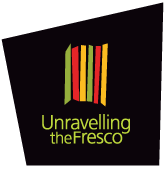A Craft Industry; Weaving
Weaving on a loom was one the daily chores of the Madawaska pioneers in the first part of the 19th century and of their descendants in the hundred years that followed. Only in the last half-century has what was formerly a common household task become perceived as a craft; looms are now found in only a very few homes.
The making of woven pieces on the loom still has the same requirements today as then, and it is still women, who excel at this craft. These woven pieces were flax fabrics, textile cloth and rugs or blankets made from rags (known as “catalognes”).
The flax fabric, a kind of linen, is woven from fibers, extracted from a flax plant. This textile plant has in its stem some very strong fiber strands, which once hackled, carded and spun give a yarn able to produce fabric on a loom. All weaving requires placing a filling thread (the weft) at right angles to parallel foundation threads (called warp) which are strung the length of the loom. The basic operation is to string the warp thread first and then weave the weft thread over and under (with a shuttle) across the loom. The resulting fabric is used to make shirts, sheets, table cloths and towels.
Cloth was woven from wool. Once sheared from the sheep, the wool was washed and disentangled with cards made of two fitted wooden boards with fine wire teeth. Wool was placed on one card and the other card combed the wool. Around 1850, carding mills appeared where farmers could have their wool carded. Once the wool was carded, it was easier to spin the wool fibers into yarn to give it strength and length; it was rolled into a spiral and at the same time, the fibers became joined. This operation was conducted using the spinning wheel. The wool was ready to be woven into cloth.
The finished woven wool cloth was wrapped around a large plank until the weaver was ready to become the seamstress and used it to manufacture overcoats, work pants, dress suits or blankets.
Another article produced on a loom was a French-Canadian blanket called a “catalogne”, made with strips of old clothes. It is still made in Madawaska and can be admired in handicraft fairs. It is a kind of weaving made of cotton and strips of rags. It was used as a rug to decorate the floor or as a blanket for warmth.
To understand the importance of the loom for Madawaska inhabitants, especially between 1785 and 1850 or so, it is necessary to know that these courageous pioneers made almost everything by hand, being too poor or having too far to go to buy clothes and other woollen goods. Father Thomas Albert wrote: “In all the houses, the loom and the spinning wheel held places of honour. The girl who had not woven her cloth on the loom could hardly be expected to find a suitable suitor because knowing this art form was her dowry...”
To what extent does this expertise still exist in Madawaska? It exists very little in the home. However, it is more than flourishing in the workshops of “Madawaska Weavers” (Les tisserands du Madawaska) a company owned by the Gervais sisters, in Saint-Leonard.
Indeed fabric is still made in the artisanal way, which is on looms still used as in the past. But the owners throughout the years have refined and perfected this clothing industry. They oversee some thirty employees who weave, sew and participate in the transformation of thousands of yards of fabric into finished products. In addition to the production of ties and scarves especially in the 1940’s, the company has added skirts, napkins, etc...
These products made in a traditional way by Madawaska Weavers are valued for their high quality and beauty. They are sold to regional clothing stores, but mainly to large stores in Montreal, Quebec and Saint John, N B. This company therefore enjoys a good reputation and high prestige.
That, very briefly, is an overview of the weaving trade, in Madawaska, past and present.
1989















